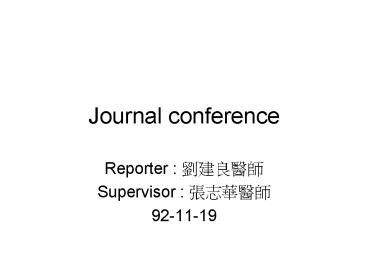Journal conference - PowerPoint PPT Presentation
1 / 30
Title:
Journal conference
Description:
Fever in children less than 36 months of age-questions and strategies for ... Pharyngeal or nasal polyp. Papilloma. Lymphoma. Mediastinal tumors. Congenital abnormaly ... – PowerPoint PPT presentation
Number of Views:84
Avg rating:3.0/5.0
Title: Journal conference
1
Journal conference
- Reporter ?????
- Supervisor ?????
- 92-11-19
2
Paper review
- Brook et al.Unexplained fever in young children
how to manage severe bacterial infection BMJ,
327(7423).November 8,20031094-1097) - Baranwal et al.Empyema thoracis A10 year
comparative review of hospitalised children from
south AsiaArc of Dis in Chid .88(11) , Nov 2003
pp.1009-1014
3
- Fever in children less than 36 months of
age-questions and strategies for management in
the emergency department. The J of Eme Med
,25(2), 2003pp149-157 - Shah et al.Risk of Bacteremia in Young Children
with Pneumonia treated as outpatients.Arc Ped and
Adol Med.154(4)April 2003p.389-392
4
Bacteremia
5
(No Transcript)
6
Low risk criteria
- For children younger than 3 months with fever and
no focus of infection - Clinical criteria
- Laboratory criteria
7
Clinical criteria
- Born at term (Gestational age gt 37 weeks) with
uncomplicated nursery stay - Previously healthy infants
- No toxic manifestations
- No focal bacterial infection (except otitis media)
8
Laboratory criteria
- WBC 5000-150000 /mm3 , lt1500 band or band /
neutorphil ratio lt 0.2 - Normal U/A(negative Gram stain , leucocyte
esterase and nitrite , WBC lt5 /HPF) - lt 8 WBC , negative Gram stain in CSF
- No infiltrate on CXR
9
Parenteral antibiotics with fever and no focus of
infection
- lt3 month
- Ampicillin 100-200 mg/kg/day q6h Gentamicin 7.5
mg/kg/day q8h - Ceftriaxine 50 mg /kg/day in single dose
- Cefotaxime 150 mg/kg/day q8h
10
- gt 3 months
- Ceftriaxone 50 mg/kg/day in a single dose
- Cefuroxime 150-200 mg/kg/day q6-8 h
11
Referral and admission criteria
- Febrile infants 7 days of age or less
- High risk febrile infants 28 90 days of age
- Toxic looking febrile children up to 36 months of
age
12
Bacteraemia and meningitis
- lt 1 months old
- GBS , E. coli , Listeria monocytogens
- Step. Pneumoniae , H. influenzae
- Stap aureus , N. meningitides
- Salmonella spp.
13
- 1- 3 months
- Strep. Pneumonia
- N. meningitides
- Salmonella spp.
- H. influenzae
- Listeria monocytogenes
14
- Over 3 months
- Strep. Pneumoniae
- H. influenzae
- N. meningitides
- Salmonella spp.
15
Bacteremia
- The incidence of post-H. influenza and
pneumococcal vaccine is probably less than 2 - Children less than 3 months of age,in low-risk
infants the prevalence of occult bacteremia is
0.2-1
16
Bacteremia
- Children aged 2-24 months with pneumonia who are
treated as outpatients are at low risk of
bacteremia - H. influenzae and Streptococcus pneumonia were
the most common bacterial pathogens
17
Empyema
18
Medical treatment
- Anti-Staph and Anti-Strep were used empirically .
Aminoglycosides used to synergistic effect in
first 5-7 days - Usually parental 7-14 days for symptomatic
relief and oral antibiotics for continued further
2 4 weeks
19
Pleural space drainage
- Continuous closed tube drainage leads to clinical
and radiological improvement within 24 hours - Tube removed once drainage becomes minimal (lt
10-15 ml/day) ,irrespective of roentgenogtaphic
resolution
20
Surgery
- Only for persistent pleural sepsis
- Tube drainage for more than 10 days , surgery is
indicated for debridement of the pleural space
21
Empyema
- Staphylococcus spp. is the most isolation ,
especially lower than 5 years old - S. Pneumonia was found from older children , and
Gram negative rods were more older children
22
Cough
23
Cause
- Infection
- Inflammation/Allergy
- Mechanical or chemical irritation
- Neoplasm
- Congenital anomalies
- Miscellaneous
24
Infection
- Upper respiratory infection
- Sinusitis , Tonsillitis , Laryngitis , Croup
- Tracheitis , Bronchiolitis , Acute bronchitis
- Pneumonia , Pleuritis
- Bronchiectasis
25
Inflammation /Allergy
- Allergic rhinitis
- Laryngeal edema
- Reactive airway disease
- Chronic bronchitis
- Cystic fibrosis
26
Mechanical or chemical irritation
- chemical fumes
- Inhaled particulates
- Foreign body aspiration
- Neck/chest contusions
- Smoking
27
Neoplasm
- Pharyngeal or nasal polyp
- Papilloma
- Lymphoma
- Mediastinal tumors
28
Congenital abnormaly
- Cleft palate
- Laryngotracheomalacia
- Laryngeal or tracheal webs
- Tracheoesophageal fistula
- Vascular ring
- Pulmonary sequestration
29
Miscellaneous
- GE reflux
- CHF
- Swallowing dysfunction
- Granulomatous disease
- Psychogenic cough
- Foreign body in otic canal
30
Life threaten
- Reactive airway disease
- Croup
- Bronchiolitis
- Forign body
- Pneumonia
- Laryngeal edema
- Pertusis
- Toxic inhalation
- CHF































